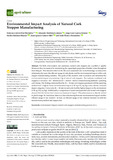Mostrar el registro sencillo del ítem
Environmental impact analysis of natural cork stopper manufacturing
| dc.creator | Flor Montalvo, Francisco Javier | es_ES |
| dc.creator | Martínez Cámara, Eduardo | es_ES |
| dc.creator | García Alcaraz, Jorge Luis | es_ES |
| dc.creator | Jiménez Macías, Emilio | es_ES |
| dc.creator | Latorre Biel, Juan Ignacio | es_ES |
| dc.creator | Blanco Fernández, Julio | es_ES |
| dc.date.accessioned | 2022-08-04T11:00:16Z | |
| dc.date.available | 2022-08-04T11:00:16Z | |
| dc.date.issued | 2022 | |
| dc.identifier.citation | Flor-Montalvo, F. J.; Martínez-Cámara, E.; García-Alcaraz, J. L.; Jiménez-Macías, E.; Latorre-Biel, J. I.; Blanco-Fernández, J. (2022). Environmental Impact Analysis of Natural Cork Stopper Manufacturing. Agriculture. 12, (5), p. 636 | en |
| dc.identifier.issn | 2077-0472 | |
| dc.identifier.uri | https://hdl.handle.net/2454/43699 | |
| dc.description.abstract | For both wine makers and customers, natural cork stoppers are a symbol of quality. More-over, they are essential for maintaining the organoleptic properties of bottled wines throughout their lifespan. This research relied on the life-cycle assessment (LCA) methodology to analyze the relationship between the efficient usage of cork planks and the environmental impact of the cork stopper manufacturing industry. The goals of this research were to analyze and determine the environmental impact of producing 1 kg of natural cork stoppers. The analysis considered cork stoppers of two sizes—24 × 44 mm and 26 × 44 mm—and two manufacturing methods—punching and turning. Our findings indicated that the 24 × 44 mm cork stoppers produced with the punching method had a slightly lower environmental impact (1.36 kg CO2 eq/kg) across the ten analyzed impact categories. Conversely, 26 × 44 mm turned corks had the highest impact on the environment (1.49 kg CO2 eq/kg). Additionally, a comparison of same-sized punched and turned cork stoppers showed that the former had a lower environmental impact. This phenomenon is directly related to plank usage. In conclusion, there is a clear relationship between environmental impact and the efficient usage of raw material. In turn, an efficient usage of raw material depends on both the manufacturing method and stopper size. | en |
| dc.description.sponsorship | This research has received funding from the Instituto de Estudios Riojanos 'IER' within the project 'Newcork2Wine'. | en |
| dc.format.mimetype | application/pdf | en |
| dc.format.mimetype | application/zip | en |
| dc.language.iso | eng | en |
| dc.publisher | MDPI | en |
| dc.relation.ispartof | Agriculture, 2022, 12 (5), p. 636 | en |
| dc.rights | © 2022 by the authors. This article is an open access article distributed under the terms and conditions of the Creative Commons Attribution (CC BY) license | en |
| dc.rights.uri | https://creativecommons.org/licenses/by/4.0/ | |
| dc.subject | Environmental impact | en |
| dc.subject | LCA | en |
| dc.subject | Manufacturing process | en |
| dc.subject | Natural cork stoppers | en |
| dc.title | Environmental impact analysis of natural cork stopper manufacturing | en |
| dc.type | Artículo / Artikulua | es |
| dc.type | info:eu-repo/semantics/article | en |
| dc.date.updated | 2022-08-04T10:47:38Z | |
| dc.contributor.department | Ingeniería Mecánica, Energética y de Materiales | es_ES |
| dc.contributor.department | Mekanika, Energetika eta Materialen Ingeniaritza | eu |
| dc.rights.accessRights | Acceso abierto / Sarbide irekia | es |
| dc.rights.accessRights | info:eu-repo/semantics/openAccess | en |
| dc.identifier.doi | 10.3390/agriculture12050636 | |
| dc.relation.publisherversion | https://doi.org/10.3390/agriculture12050636 | |
| dc.type.version | Versión publicada / Argitaratu den bertsioa | es |
| dc.type.version | info:eu-repo/semantics/publishedVersion | en |



